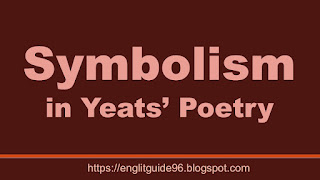Symbolism in Yeats’ Poetry
Yeats’
poetry is replete with symbols. He has been regarded as one of the greatest symbolists
in English literature. In his poetry the same symbol is often used for
different purposes and in different contexts. His symbols are derived from
occult studies which included a fascination for fairies, banshees, astrology,
automatic writing and prophetic dreams. He had come to know from Madame
Blavatsky that the great memory of Nature preserved the legends of all nations.
This made him feel that he could come in contact with Anima Mundi through
symbols drawn from Irish legends—Oisin or Aengus, the hound with one red ear or
the white dear with no horns. Arbitrary occult symbols like that of the ‘rose’,
‘cross’, ‘lily’, ‘bird’, ‘tree’, ‘moon’ and the ‘sun’, Yeats found in the
Kabalistic, theosophical and other such works.
The
Symbol: ‘the Rose’
The
rose symbol occurs frequently in the poems of W.B. Yeats. Most of his poems, which
have the rose as the central symbol, can be found in the volume called The Rose
which appeared in 1933. In The Rose or Peace, the symbol of ‘the rose’ means
earthly love but in The Rose of The World this symbol means, on the one hand
transient earthly love and beauty and on the other hand eternal love and
beauty, thus, complicating the meaning. The shift in meaning of the same symbol
in different poems of Yeats, at times baffles the readers. In The Rose of
Battle, ‘the rose’ is a refuge from earthly love, symbolizing God’s side in the
battle of spirit against matter. But this very symbol stands for the power of
creative imagination and occult philosophy in the poem called To the Rose upon
the Rod of Time.
The
Symbol: ‘Dance’
According
to Yeats the value of a symbol is in its richness or indefiniteness of
reference. This, he feels, makes it much more mysterious and powerful than
allegory with its single meaning. Like ‘the rose’, the symbol of the ‘dance’ is
closely connected with Yeats’s “system” and often appears in his poetry. It is
used, at times to indicate patterned movement and at times to indicate joyous
energy. Upon a Dying Lady is a poem in which the woman’s soul “flies to the pre-destined
dancing place.” Of course, this per-destined dancing place suggests all that is
traditionally associated with a heavenly after life — perfect unity, peace and
joy. In the closing stanza of the poem called Among School Children the concept
of unity is invoked once again by the symbol of the ‘dance’. The first four
lines of the closing stanza depict a heavenly or an ideal state of balance and
unity but the focus in the last four lines shifts to life itself giving the suggestion
that one cannot separate the part from the whole, nor body from spirit, or
being from becoming.
The
Symbol: ‘Byzantium’
‘Byzantium’,
too, has been used by Yeats as a symbol for unity and perfection. Yeats felt
that Byzantium and its golden age is symbolical of a kind of unity and
perfection such as the world had never known before or since. He believed that
the religious, aesthetic and practical life were one in the early Byzantium. He
saw in the Byzantine culture and unity of being, a state in which art and life
interpenetrated each other. In his poem Sailing to Byzantium ‘Byzantium’ becomes
the symbol of a perfect world. The poet rejects the world of birth and death
and decides for Byzantium. He thinks he will be able to defeat Time by taking
refuge in the world of art because art itself is timeless. He ignores the
sensual music made by “that dying generation” (mortal birds) in favour of the
ethereal music produced by the Byzantine birds of hammered gold and gold enameling.
‘Byzantium’ suggests a far-off, unfamiliar civilization which is symbolical of
the ideal, aesthetic existence he longs for.
Symbols
in “The Second Coming”
A
study of symbolism in the poem The Second Coming will show us the nature of the
symbols Yeats was wont to use. They are taken partly from private doctrine,
partly from Yeats’ direct sense of the world around him and partly from both
these sources. For Yeats one of the qualities that made life valuable under the
dying aristocratic social tradition was the “ceremony of innocence” a phrase
that occurs in this poem. The expression “falcon and the falconer” have both a
symbolic and a doctrinal reference.
Opposing
Symbols in “A Dialogue of Self and Soul”
An
example of two opposing symbols can be seen in A Dialogue of Self and Soul. On
the one hand there is the symbol of Sato’s sword while on the other hand there
is the winding stair that leads to darkness: an after-life from where there is
no return. The ‘Soul’ is inclined to contemplate on the winding stair which
symbolizes the path of escape. But the ‘Self’ prefers to contemplate on Sato’s
sword instead. However, in Meditations a Time of Civil War—Yeats used this same
as a symbol of art which is imperishable and contrasted it with the artist who
is perishable. But in the poem Self and Soul the word is used as a masculine symbol
for life, war, love, and sex. The ‘Self’ in the second section of the poem
reasserts its right to live life again and to suffer as man. It represents the
totality of living, whereas the ‘Soul’ represents withdrawal from life. It
stands for abstraction.
Thus,
winding stairs, spirals of all kinds, gyres and spinning tops are some of the symbols
which are of great importance in Yeats’ later poetry. These symbols serve as a
means of resolving some of the dichotomies in life that had arrested Yeats’
interest from the very beginning of his literary career.










0 Comments